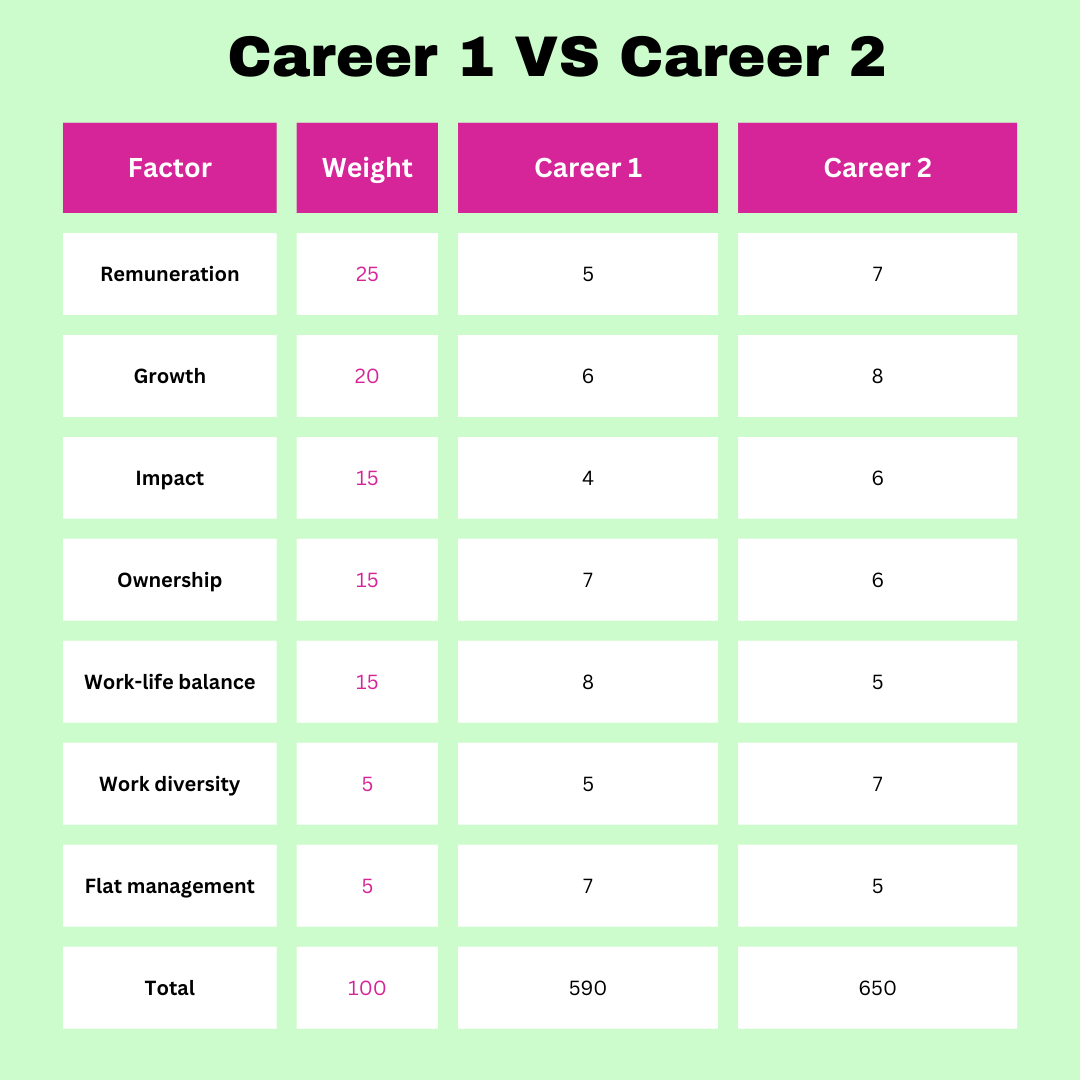Make better decisions
Use 3Cs to decide for yourself and the team.
Dear Fit Rich,
When was the last time you struggled to decide something? When I became a Digital Product Manager, one of my biggest struggles was making decisions. There are many options, voices and conflicts. How can you ensure your decision is right? I was pulled into a decision dilemma.
To solve the challenge, I adopted useful frameworks. For example, Intel uses the RICE model to decide which features to prioritise in next quarter’s roadmap. As a leader of yourself and your team, you learn to make wise decisions to ensure everyone is heading in the right direction.
I twisted the RICE model to help me make big life decisions. These are the 3Cs model I often use:
1. Collect and prioritise factors
What are the factors you care about the most now? What are their priorities? It helps you identify what’s important to you so you know which option favours you more.
2. Calculate scores for options
Score each option by each factor, then calculate the total score for each option. You have a clear overview of which option fulfils you more.
3. Compare the worst and best scenarios
Ask yourself: Which option I can't afford to lose? It is a dual diligence on the choice made in #2.
The 3Cs model works in personal or professional decisions. Let me use my career decision as an example. Previously, I struggled with 2 career options:
Career 1: My current domain. This role challenges me with multiple skill sets, allows me to create impact and gives me ownership. My current company is cultural and has stable business growth. My boss is people-oriented, my colleagues are friendly and there is a work-life balance.
Career 2: A new domain. This role requires me to lead people who might be more experienced and older than me. I will be in a year-long training to equip myself with domain knowledge and leadership skills. It is more hierarchical and I am not sure if it suits me.
Confronting the dilemma, I prioritised important factors, talked to fellows and scored each option.
Here is how I find my answer:
I weigh each factor to determine each level of importance (With 100 as the total), e.g. “Remuneration” is 25/100.
I score each career by each factor (with 10 as the total), e.g. Career 1 scores 5/10 for the “Remuneration” factor.
I summarise the total score for each career as (Factor 1 weight * Score + Factor 2 weight *Score + …), e.g. for Career 1, the total score is calculated as 25*5+ 20*6+ 15*4…=590
Compare the total scores of Career 1 & Career 2. The one with the highest score is my choice.
Despite the uncertainty of Career 2, it gets a higher total score.
To validate my decision, I compare the best and worst scenarios for each option.
Career 1:
Best: I climb the corporate ladder every 2-3 years steadily, transforming from individual contributor to mentor, and from mentor to people manager.
Worst: I get too comfortable with the stable environment and grow less.
Career 2:
Best: I work in an environment where I am paid well, grow exponentially and impact more. Rotate in different units periodically to learn new skills.
Worst: It doesn’t suit me and I return to my previous domain.
My biggest fear is trying a new domain with uncertainty and facing a more hierarchical culture. Why do I switch to something new if I am doing ok currently? What if it doesn’t work out eventually?
I soon realised that deep down I want to unlock my possibilities in life. I want to see how far I can go. I want to learn and impact more by wearing a holistic lens. When an opportunity lands, why don’t you take it? You never know until you try. You would rather try and error than regret not trying.
Stop being afraid of what could go wrong;
Start being positive about what could go right.
- Tony Robbins, Author, coach and speaker
Very often, you fear making “bad decisions”. The truth is, each decision is a good decision as long as you think it through. Regardless of the result, you learn what works and does not work.
Do all the greatest leaders, creators or entrepreneurs succeed on a go? Thomas Alva Edison invented the light bulb after failing 6000 times; Steve Jobs was ousted from the company he co-founded; Martin Luther King was arrested 20 times before he reformed civil rights.
Great leaders learn from each decision.
When you have a clear overview of what is important to you and the value of each option, picking an option looks less hard.
There is no “right” or “wrong” answer. In the Product World, we often say “Test fast, fail fast & move fast”. Let the number speak for itself. Whenever you want to know if something works, try it out fast for a short while. Don’t know if people like this product? Launch first and review the usage data. Don’t know if this relationship works? Try it for a few months and see how it goes. Don’t know if you like this job? Try it during the probation period and reflect. As long as you think it through, decide first and review it later.
You only know when you try.
Life is a squiggle, not a straight line. It is okay to rise, fall and rise again. When you see life as an experiment and adventure, you gain the courage to decide. As long as you think it through using the 3Cs, any decision is a good decision.
Use the 3Cs:
Collect and prioritise factors
Calculate scores for options
Compare the worst and best scenarios
May you be brave enough to embark on an adventure!
A question for you:
What have you learnt from the big life decision you last made as a leader (for yourself or a team)?
Share with me by replying to this email😉
Hungry for personal growth? The Fit Rich is a community of proactive and growth minds. Join the community to get fresh insights on growing your career, health, wealth, relationships, mindfulness and more.
To brave leaders,
Ruby



